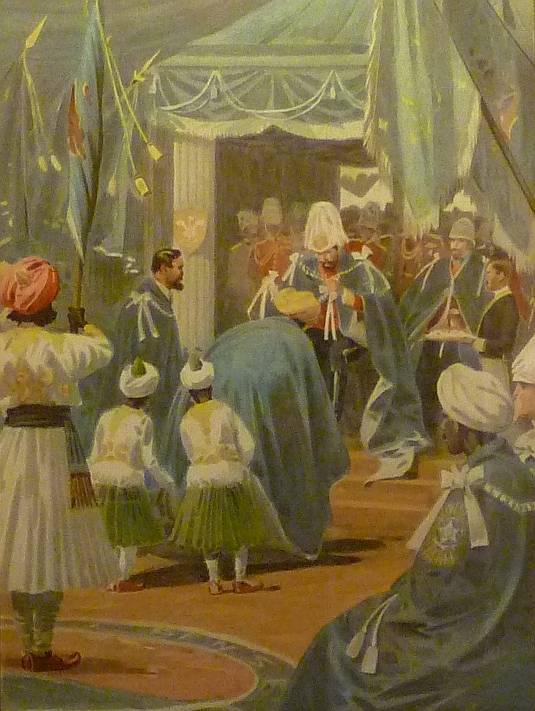
Recently constructed sandstone entrance to Coronation Park. The large tract of ground seen within, just to the north of the old city of Delhi, was originally the site of the three grand Delhi Durbars — the Proclamation Durbar of 1877; the Durbar to announce the accession of Edward VII in 1903; and, equally important, the 1911 one when George V, the new King-Emperor, declared that the capital would be shifted from Kolkata (Calcutta) to Delhi. The area, to which a number of statues from the Raj period have been relegated, is undergoing a long process of conversion into a heritage site with landscaped parkland.

The impressive raised obelisk that stands in the middle of the tract carries a plaque commemorating the last of the Durbars mentioned above.



Left to right: (a) View of the obelisk showing its height relative to a human being (the author's niece). (b) The splendour of the Durbars, as shown in a picture hanging under a portrait of Queen Victoria at the Imperial Hotel, New Delhi (by kind permission of the hotel). (c) Surveying the park is Charles Sargeant Jagger's George V, moved from its original position under an impressive canopy at India Gate, New Delhi (see especially the last picture there).
This was the scene of incredible splendour on those Durbar days. Jan Morris writes:
The tented camps extablished for these occasions, on flat ground north of the old city of Delhi, were almost cities in themselves. They had their own railways, telephone services, paved roads, water-mains, electric power, and the durbar of 1911, whose tents covered ten square miles, and whose railway station had ten platforms, was designed to accommodate 25,000 people — as many as Delhi itself. [217]
Coronation Park has long been earmarked for development as a tourist attraction: the original plan was to restore it in time for the 2011 centenary of the last Durbar (see Verma), and it has featured on some tourist maps for several years. However, progress has been slow (last seen in February 2015).
Photographs, caption, and commentary by Jacqueline Banerjee. [You may use these images without prior permission for any scholarly or educational purpose as long as you (1) credit the photographer and (2) link your document to this URL or credit the Victorian Web in a print one.]
Other statues removed to Coronation Park, shown on our site
- Better views of Jagger's George V
- Jagger's Lord Hardinge of Penhurst
- Herbert Hampton's Sir John Jenkins
- Hampton's Sir Guy Fleetwood Wilson
- Sir William Reid Dick's Marquess of Willingdon
References
Morris, Jan, with Simon Winchester. Stones of Empire: The Buildings of the Raj. Oxford: Oxford University Press, 2005. Print.
Verma, Richi. "No Crowning Glory at Delhi's 100-Yr Bash." Times of India. 20 Oct. 2011. Web. 16 March 2012.
Last modified 5 June 2017